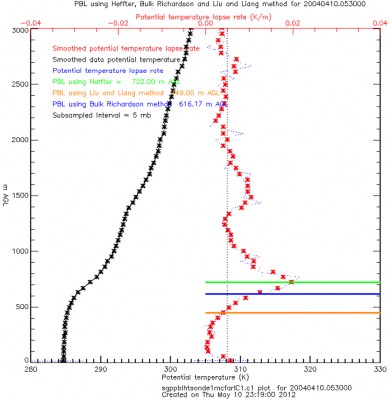New Evaluation Product Estimates Planetary Boundary Layer Height
Published: 3 July 2012

Planetary boundary layer (PBL) height (or mixing-layer depth) can vary significantly with time due to a number of factors, including large-scale dynamics, cloudiness, convective mixing, and the diurnal cycle of solar radiation. The structure and depth of the PBL are important to a wide range of atmospheric processes, such as cloud formation, aerosol mixing and transport, and chemical mixing and transport. A new ARM value-added product (VAP) estimates PBL height from radiosonde measurements, and evaluation data for this VAP (PBLHTSONDE) are now available.
PBLHTSONDE implements three different methods for estimating PBL height. Two methods are based on gradients in the potential temperature profile, while a third method is based on the profile of the bulk Richardson number. The differences between the estimates from the various methods can be considered a partial estimate of the uncertainty in the PBL height values. One of the methods also classifies the PBL into regimes (stable, convective, or neutral). Both detailed files for each radiosonde launch and yearly files containing a time series of PBL height over the year are produced.
Evaluation data have been produced for 2001–2011 at the ARM Southern Great Plains site, including radiosondes launched at supplemental sites for the Midlatitude Continental Convective Clouds Experiment (MC3E) during April–June 2011. Evaluation data have also been produced for the ARM Mobile Facility (AMF) deployment at Gan Island (2011–2012). Further details of the PBLHTSONDE procedure can be found in the draft technical report included in the data directory. Currently, PBLHTSONDE is in an evaluation period, and any comments or suggestions are welcome.
More information on PBLHTSONDE is available at the VAP web page. To access these data, log in to the Data Archive. (Go here to request an account.)
The ARM Climate Research Facility is a DOE Office of Science user facility. The ARM Facility is operated by nine DOE national laboratories, including .
Keep up with the Atmospheric Observer
Updates on ARM news, events, and opportunities delivered to your inbox
ARM User Profile
ARM welcomes users from all institutions and nations. A free ARM user account is needed to access ARM data.


















